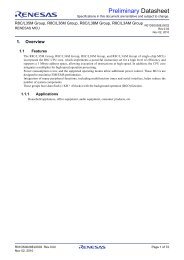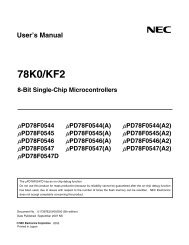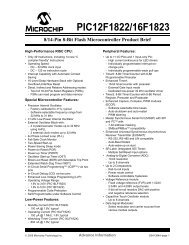xmega a3u - Elfa
xmega a3u - Elfa
xmega a3u - Elfa
You also want an ePaper? Increase the reach of your titles
YUMPU automatically turns print PDFs into web optimized ePapers that Google loves.
XMEGA A3U<br />
7.3.4 Production Signature Row<br />
The production signature row is a separate memory section for factory programmed data. It contains<br />
calibration data for functions such as oscillators and analog modules. Some of the<br />
calibration values will be automatically loaded to the corresponding module or peripheral unit<br />
during reset. Other values must be loaded from the signature row and written to the corresponding<br />
peripheral registers from software. For details on calibration conditions, refer to ”Electrical<br />
Characteristics” on page 70.<br />
The production signature row also contains an ID that identifies each microcontroller device type<br />
and a serial number for each manufactured device. The serial number consists of the production<br />
lot number, wafer number, and wafer coordinates for the device. The device ID for the available<br />
devices is shown in Table 7-1.<br />
The production signature row cannot be written or erased, but it can be read from application<br />
software and external programmers.<br />
Table 7-1.<br />
Device ID bytes for Atmel AVR XMEGA A3U devices.<br />
Device<br />
Device ID bytes<br />
Byte 2 Byte 1 Byte 0<br />
AT<strong>xmega</strong>64A3U 42 96 1E<br />
AT<strong>xmega</strong>128A3U 42 97 1E<br />
AT<strong>xmega</strong>192A3U 44 97 1E<br />
AT<strong>xmega</strong>256A3U 42 98 1E<br />
7.3.5 User Signature Row<br />
The user signature row is a separate memory section that is fully accessible (read and write)<br />
from application software and external programmers. It is one flash page in size, and is meant<br />
for static user parameter storage, such as calibration data, custom serial number, identification<br />
numbers, random number seeds, etc. This section is not erased by chip erase commands that<br />
erase the flash, and requires a dedicated erase command. This ensures parameter storage during<br />
multiple program/erase operations and on-chip debug sessions.<br />
7.4 Fuses and Lock bits<br />
The fuses are used to configure important system functions, and can only be written from an<br />
external programmer. The application software can read the fuses. The fuses are used to configure<br />
reset sources such as brownout detector and watchdog, startup configuration, JTAG enable,<br />
and JTAG user ID.<br />
The lock bits are used to set protection levels for the different flash sections (that is, if read<br />
and/or write access should be blocked). Lock bits can be written by external programmers and<br />
application software, but only to stricter protection levels. Chip erase is the only way to erase the<br />
lock bits. To ensure that flash contents are protected even during chip erase, the lock bits are<br />
erased after the rest of the flash memory has been erased.<br />
An unprogrammed fuse or lock bit will have the value one, while a programmed fuse or lock bit<br />
will have the value zero.<br />
Both fuses and lock bits are reprogrammable like the flash program memory.<br />
8386B–AVR–12/11<br />
13

















